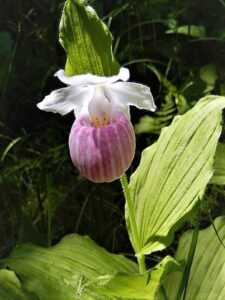By: Karl Deibert
Orchids have captivated people for millennia. They are a massively diverse group of plants that have colonized almost every corner of the world minus Antarctica. There is an estimated 30,000 naturally occurring species making them the largest flowering plant family. We are still finding new species as they constantly evolve new ways to trick insects and now people into pollinating them and carrying on the next generation.

They can take many forms, vary drastically in size from penny sized to 20 foot giants, some smell intoxicating while others may make you sick.
When most people today hear of orchids, they often think of wild and exotic tropical flowers but many are found in the northern latitudes. A hardy orchid is any orchid that can withstand temperatures below 45 degrees Fahrenheit. There are some that like it much colder, the charming and diminutive Spotted Lady Slipper (Cypripedium guttaum) can be found blooming in snow, above the Arctic Circle. While there are many that can be difficult for us to grow we have a number of good choices for our Mid-Atlantic gardens.
Maryland alone hosts 57 species of wild orchids, two of which originate from Asia with the other 55 being native. There are quite a few that can easily be overlooked while walking through the woods but the large and showy lady slippers will stop a person in their tracks. Long revered as jewels of the forest, these pink, yellow or white flowers have a n arching good with two wing like sepals on either side flanking a lower fused petal that forms a pouch or “slipper” to trap potential pollinators forcing the little bees past a stinky ball of pollen and out the backside of the flower.

While our most common Cypripedium is highly depended on special relationship with fungi and are nearly impossible to grow outside of mature woods, there are a few native as well as several Asian species and hybrids in between the two that make wonderful additions to the garden. The Chinese Ground Orchid or Bletilla striata is the most readily available of the hardy orchids. They put on quite a show for about six weeks in late spring with dozens of flower spikes held above attractively rubbed leaves. We also have some evergreen orchids known as the Jewel orchids, the most common being the Goodyera or Rattlesnake plantains.

The flowers on these guys are usually not much to look at but their dark green leaves are covered in the most amazing crystalline veins. Goodyera pubescens is one of the most common North American orchids and sometimes shows up as a welcome volunteer in the garden.
Orchids are very slow growing, some need a few seasons while others may take as many as 8 years from the time they sprout until the time they flower and are ready to set seed of their own. Even though they are widespread, many orchids are in trouble from various threats like pollinator collapse, over collecting, and habitat destruction. It’s vital when purchasing orchids to be sure they’re from a nursery and not wild stock. I encourage everyone to grow orchids in their gardens or to get out and see them in the forests, meadows and marshes all around us. You’ll find just how captivating these unique little flowers can be.





